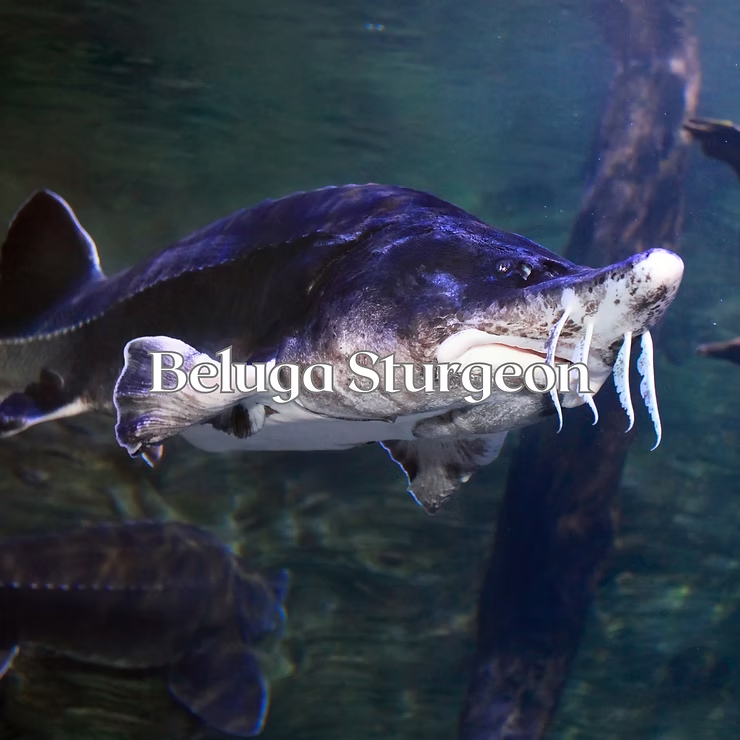Introduction
The Beluga Sturgeon is one of the most remarkable fish species in the world. Famous for its massive size, long lifespan, and role in producing highly prized caviar, it has captured the attention of scientists, conservationists, and luxury markets alike. Unfortunately, this ancient species is now critically endangered, threatened by overfishing, habitat destruction, pollution, and illegal trade. This article explores the Beluga Sturgeon’s biology, importance, threats, and the global efforts underway to ensure its survival.
What is a Beluga Sturgeon?
Appearance
Beluga Sturgeons can grow up to 20 feet long and weigh more than 2,000 pounds, making them one of the largest freshwater fish. Their grayish-blue backs, white undersides, and bony plates known as scutes give them a prehistoric appearance. With a pointed snout, protruding lower jaw, and streamlined body, these fish are powerful swimmers capable of navigating strong river currents. They can live over a century, symbolizing resilience and endurance.
Habitat
Beluga Sturgeons are native to the Caspian and Black Seas and migrate into rivers like the Volga and Danube to spawn. They prefer brackish waters with muddy or sandy bottoms and are known for their seasonal anadromous migration—moving between rivers and seas to reproduce. Habitat loss caused by dams and river modifications has severely disrupted these patterns, limiting their access to spawning grounds.
Diet
- Small fish: Their primary food source.
- Crustaceans: Including shrimp and crabs.
- Insect larvae: Abundant in rivers and estuaries.
- Algae and plants: Supplementary food when animal prey is scarce.
Beluga Sturgeons use their protrusible mouths to suck in prey, making them efficient feeders that adapt to changing conditions.
Reproduction
Reaching maturity at about 15 years old, females spawn in gravel riverbeds, releasing thousands of eggs. Few survive, as eggs and fry face high predation and environmental pressures. Their slow reproduction rate, combined with human threats, makes population recovery difficult. The species relies heavily on successful migration and spawning cycles, which are now increasingly disrupted.
Why Are Beluga Sturgeons Endangered?
- Overfishing: Driven by demand for caviar, their population has declined by more than 90% in 40 years.
- Habitat destruction: Dams and pollution reduce spawning areas and food availability.
- Pollution: Industrial chemicals and plastics harm their health and reproduction.
The Importance of Beluga Sturgeons
Caviar Production
Beluga caviar is considered the most luxurious in the world, with large, glossy eggs prized for their buttery flavor. This demand has fueled both aquaculture initiatives and illegal trade. Sustainable farming is now promoted to reduce wild catches while meeting market demand.
Ecosystem Balance
As a keystone species, Beluga Sturgeons regulate fish and invertebrate populations, maintaining ecosystem stability. Their presence also indicates water quality, making them vital bioindicators of environmental health.
Conservation Efforts
- Fishing regulations: Quotas, seasonal closures, and size restrictions limit exploitation.
- Habitat restoration: Efforts focus on improving river flow and water quality.
- Public awareness: Campaigns educate communities about sustainable practices and the importance of conservation.
Illegal Trade
Black Market
The high price of caviar fuels smuggling, often using false documents and hidden transport methods. This underground trade undermines conservation and accelerates population decline.
Smuggling Techniques
Caviar is concealed in common items such as containers, bottles, or food packaging. Stronger border checks and international cooperation are essential to combat this threat.
The Future of Beluga Sturgeons
Sustainable Fishing Practices
Protecting spawning grounds, enforcing quotas, and adopting selective fishing gear are vital to ensuring survival while balancing demand for caviar.
International Cooperation
Conservation success depends on collaboration between countries. Shared enforcement, habitat restoration projects, and awareness campaigns are crucial for long-term survival.
Conclusion
The Beluga Sturgeon is both a symbol of luxury and a fragile survivor of centuries. Its dramatic decline highlights the urgent need for conservation. With strict regulations, sustainable practices, and global cooperation, there is hope for recovery. Protecting the Beluga Sturgeon is not just about saving a species—it is about preserving ecosystems, cultural heritage, and biodiversity for future generations.
Frequently Asked Questions
- How big do Beluga Sturgeons grow? Up to 20 feet and 2,000 pounds.
- How long do they live? Over 100 years.
- What do they eat? Mainly fish, crustaceans, and insect larvae.
- Why are they endangered? Overfishing, habitat loss, and pollution.
- Why are they important? For caviar production and ecosystem balance.

